Importance of Risk Register in Project Management
VerifiedAdded on 2022/12/30
|10
|2462
|39
AI Summary
This report focuses on the development of the risk register and the importance of the risk register in the overall risk management plan. Furthermore, this report involves the communication strategies and models that can be adopted by the project manager across the team to achieve the targets. Lastly, it will define the methodologies that will be used to complete the project case study.
Contribute Materials
Your contribution can guide someone’s learning journey. Share your
documents today.

Project Management
Secure Best Marks with AI Grader
Need help grading? Try our AI Grader for instant feedback on your assignments.

Table of Contents
TASK 2............................................................................................................................................3
INTRODUCTION...........................................................................................................................3
MAIN BODY..................................................................................................................................3
Risk Register................................................................................................................................3
Importance of Risk Register........................................................................................................5
Report..........................................................................................................................................6
CONCLUSION................................................................................................................................9
REFRENCES.................................................................................................................................10
Books and Journal......................................................................................................................10
TASK 2............................................................................................................................................3
INTRODUCTION...........................................................................................................................3
MAIN BODY..................................................................................................................................3
Risk Register................................................................................................................................3
Importance of Risk Register........................................................................................................5
Report..........................................................................................................................................6
CONCLUSION................................................................................................................................9
REFRENCES.................................................................................................................................10
Books and Journal......................................................................................................................10
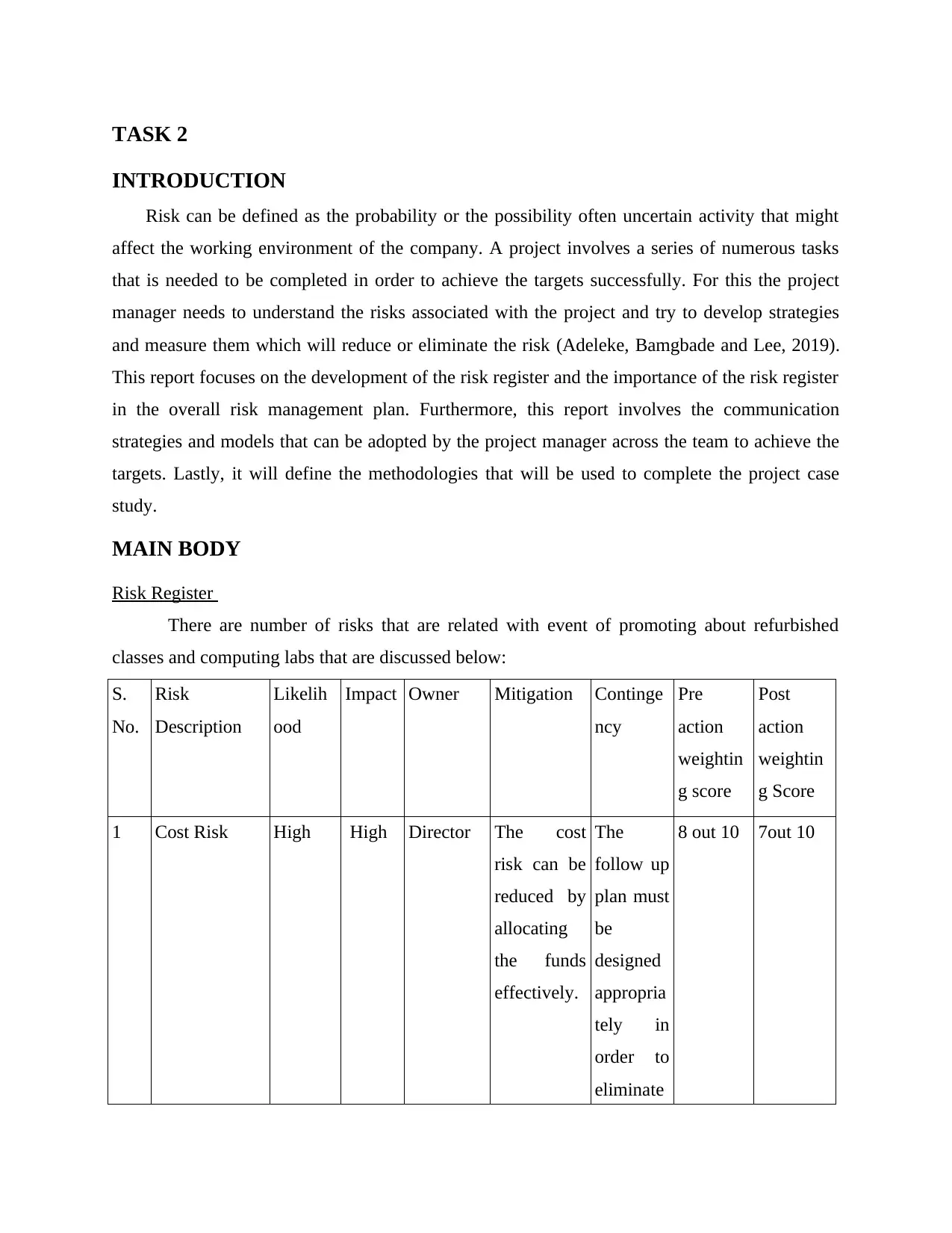
TASK 2
INTRODUCTION
Risk can be defined as the probability or the possibility often uncertain activity that might
affect the working environment of the company. A project involves a series of numerous tasks
that is needed to be completed in order to achieve the targets successfully. For this the project
manager needs to understand the risks associated with the project and try to develop strategies
and measure them which will reduce or eliminate the risk (Adeleke, Bamgbade and Lee, 2019).
This report focuses on the development of the risk register and the importance of the risk register
in the overall risk management plan. Furthermore, this report involves the communication
strategies and models that can be adopted by the project manager across the team to achieve the
targets. Lastly, it will define the methodologies that will be used to complete the project case
study.
MAIN BODY
Risk Register
There are number of risks that are related with event of promoting about refurbished
classes and computing labs that are discussed below:
S.
No.
Risk
Description
Likelih
ood
Impact Owner Mitigation Continge
ncy
Pre
action
weightin
g score
Post
action
weightin
g Score
1 Cost Risk High High Director The cost
risk can be
reduced by
allocating
the funds
effectively.
The
follow up
plan must
be
designed
appropria
tely in
order to
eliminate
8 out 10 7out 10
INTRODUCTION
Risk can be defined as the probability or the possibility often uncertain activity that might
affect the working environment of the company. A project involves a series of numerous tasks
that is needed to be completed in order to achieve the targets successfully. For this the project
manager needs to understand the risks associated with the project and try to develop strategies
and measure them which will reduce or eliminate the risk (Adeleke, Bamgbade and Lee, 2019).
This report focuses on the development of the risk register and the importance of the risk register
in the overall risk management plan. Furthermore, this report involves the communication
strategies and models that can be adopted by the project manager across the team to achieve the
targets. Lastly, it will define the methodologies that will be used to complete the project case
study.
MAIN BODY
Risk Register
There are number of risks that are related with event of promoting about refurbished
classes and computing labs that are discussed below:
S.
No.
Risk
Description
Likelih
ood
Impact Owner Mitigation Continge
ncy
Pre
action
weightin
g score
Post
action
weightin
g Score
1 Cost Risk High High Director The cost
risk can be
reduced by
allocating
the funds
effectively.
The
follow up
plan must
be
designed
appropria
tely in
order to
eliminate
8 out 10 7out 10
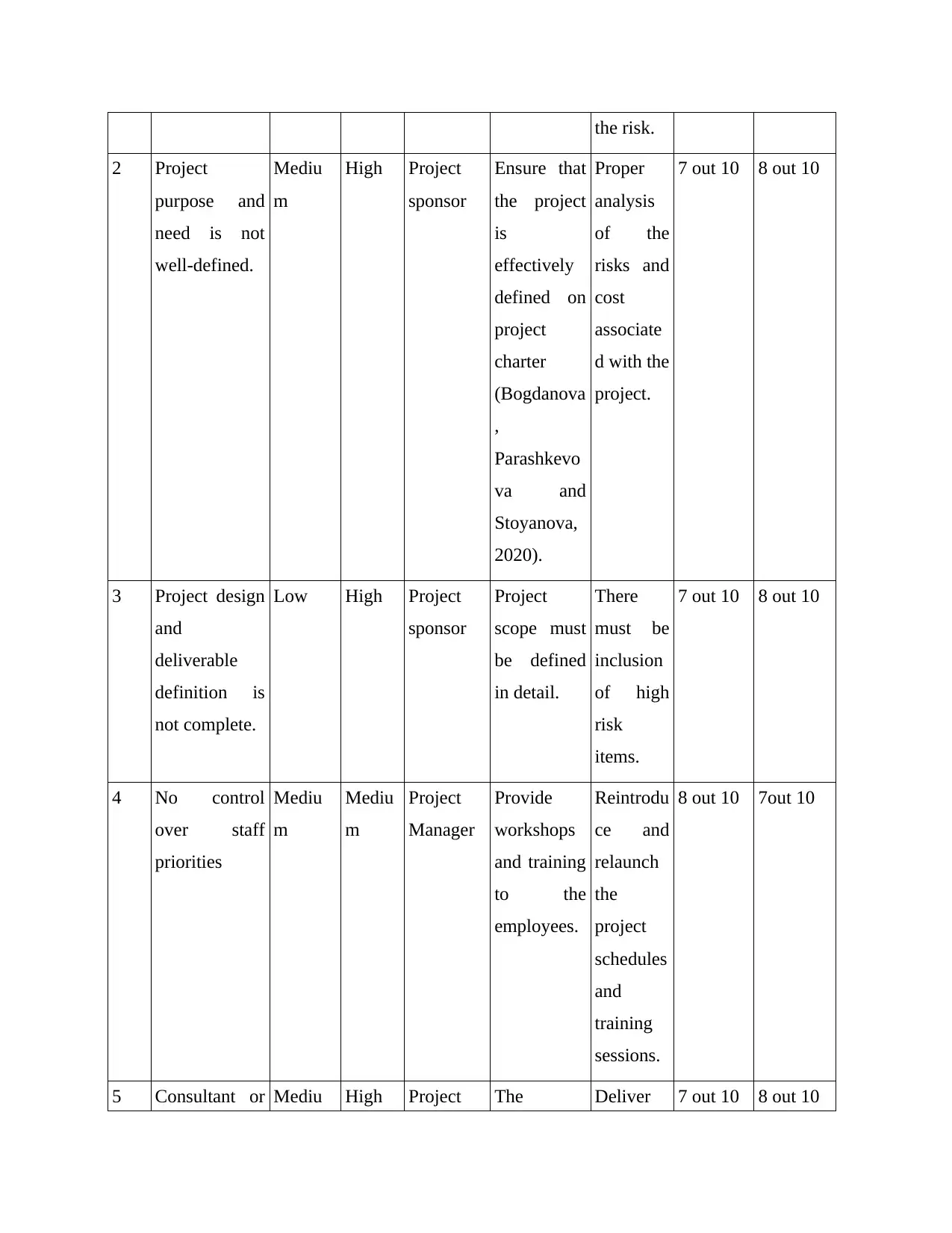
the risk.
2 Project
purpose and
need is not
well-defined.
Mediu
m
High Project
sponsor
Ensure that
the project
is
effectively
defined on
project
charter
(Bogdanova
,
Parashkevo
va and
Stoyanova,
2020).
Proper
analysis
of the
risks and
cost
associate
d with the
project.
7 out 10 8 out 10
3 Project design
and
deliverable
definition is
not complete.
Low High Project
sponsor
Project
scope must
be defined
in detail.
There
must be
inclusion
of high
risk
items.
7 out 10 8 out 10
4 No control
over staff
priorities
Mediu
m
Mediu
m
Project
Manager
Provide
workshops
and training
to the
employees.
Reintrodu
ce and
relaunch
the
project
schedules
and
training
sessions.
8 out 10 7out 10
5 Consultant or Mediu High Project The Deliver 7 out 10 8 out 10
2 Project
purpose and
need is not
well-defined.
Mediu
m
High Project
sponsor
Ensure that
the project
is
effectively
defined on
project
charter
(Bogdanova
,
Parashkevo
va and
Stoyanova,
2020).
Proper
analysis
of the
risks and
cost
associate
d with the
project.
7 out 10 8 out 10
3 Project design
and
deliverable
definition is
not complete.
Low High Project
sponsor
Project
scope must
be defined
in detail.
There
must be
inclusion
of high
risk
items.
7 out 10 8 out 10
4 No control
over staff
priorities
Mediu
m
Mediu
m
Project
Manager
Provide
workshops
and training
to the
employees.
Reintrodu
ce and
relaunch
the
project
schedules
and
training
sessions.
8 out 10 7out 10
5 Consultant or Mediu High Project The Deliver 7 out 10 8 out 10
Paraphrase This Document
Need a fresh take? Get an instant paraphrase of this document with our AI Paraphraser
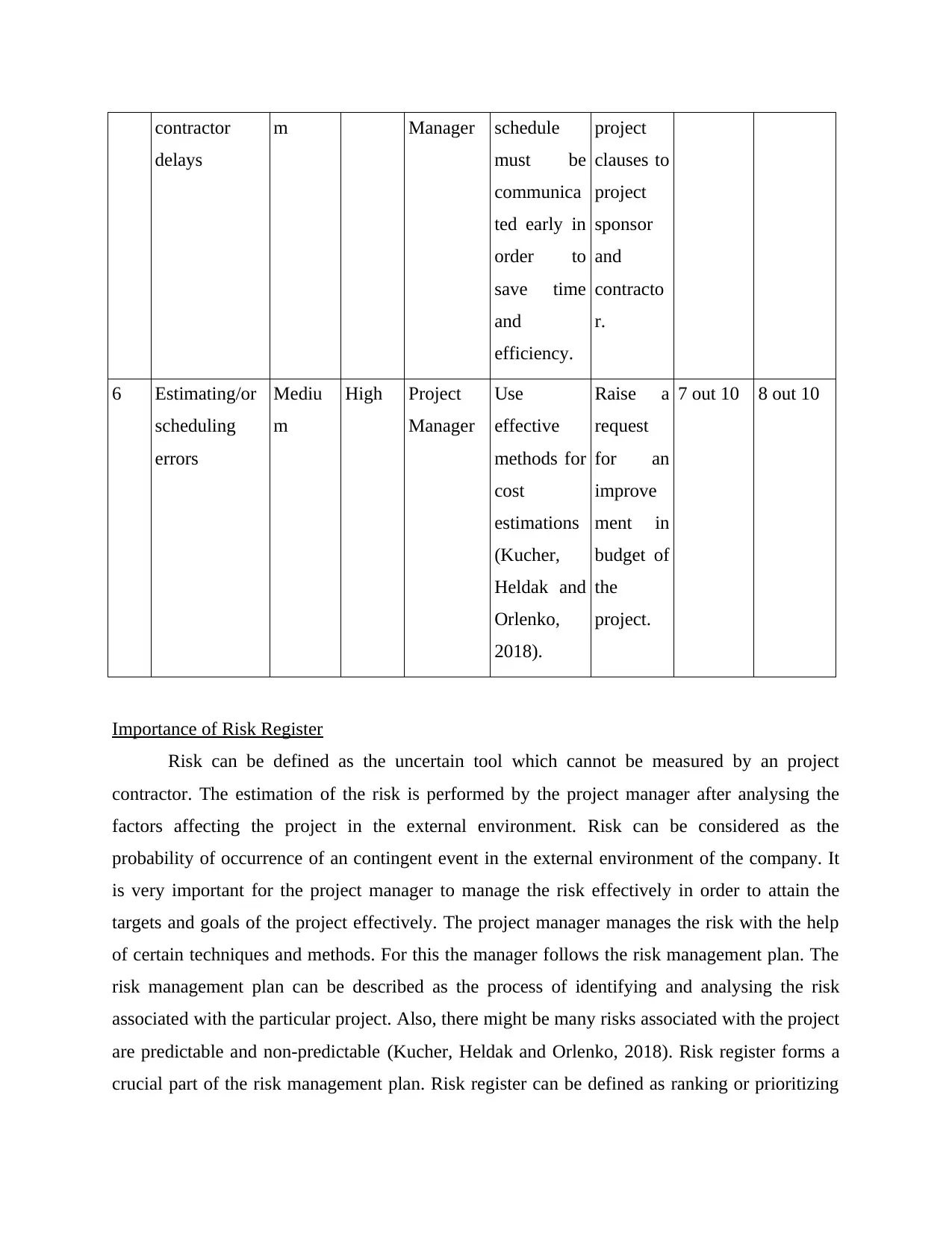
contractor
delays
m Manager schedule
must be
communica
ted early in
order to
save time
and
efficiency.
project
clauses to
project
sponsor
and
contracto
r.
6 Estimating/or
scheduling
errors
Mediu
m
High Project
Manager
Use
effective
methods for
cost
estimations
(Kucher,
Heldak and
Orlenko,
2018).
Raise a
request
for an
improve
ment in
budget of
the
project.
7 out 10 8 out 10
Importance of Risk Register
Risk can be defined as the uncertain tool which cannot be measured by an project
contractor. The estimation of the risk is performed by the project manager after analysing the
factors affecting the project in the external environment. Risk can be considered as the
probability of occurrence of an contingent event in the external environment of the company. It
is very important for the project manager to manage the risk effectively in order to attain the
targets and goals of the project effectively. The project manager manages the risk with the help
of certain techniques and methods. For this the manager follows the risk management plan. The
risk management plan can be described as the process of identifying and analysing the risk
associated with the particular project. Also, there might be many risks associated with the project
are predictable and non-predictable (Kucher, Heldak and Orlenko, 2018). Risk register forms a
crucial part of the risk management plan. Risk register can be defined as ranking or prioritizing
delays
m Manager schedule
must be
communica
ted early in
order to
save time
and
efficiency.
project
clauses to
project
sponsor
and
contracto
r.
6 Estimating/or
scheduling
errors
Mediu
m
High Project
Manager
Use
effective
methods for
cost
estimations
(Kucher,
Heldak and
Orlenko,
2018).
Raise a
request
for an
improve
ment in
budget of
the
project.
7 out 10 8 out 10
Importance of Risk Register
Risk can be defined as the uncertain tool which cannot be measured by an project
contractor. The estimation of the risk is performed by the project manager after analysing the
factors affecting the project in the external environment. Risk can be considered as the
probability of occurrence of an contingent event in the external environment of the company. It
is very important for the project manager to manage the risk effectively in order to attain the
targets and goals of the project effectively. The project manager manages the risk with the help
of certain techniques and methods. For this the manager follows the risk management plan. The
risk management plan can be described as the process of identifying and analysing the risk
associated with the particular project. Also, there might be many risks associated with the project
are predictable and non-predictable (Kucher, Heldak and Orlenko, 2018). Risk register forms a
crucial part of the risk management plan. Risk register can be defined as ranking or prioritizing
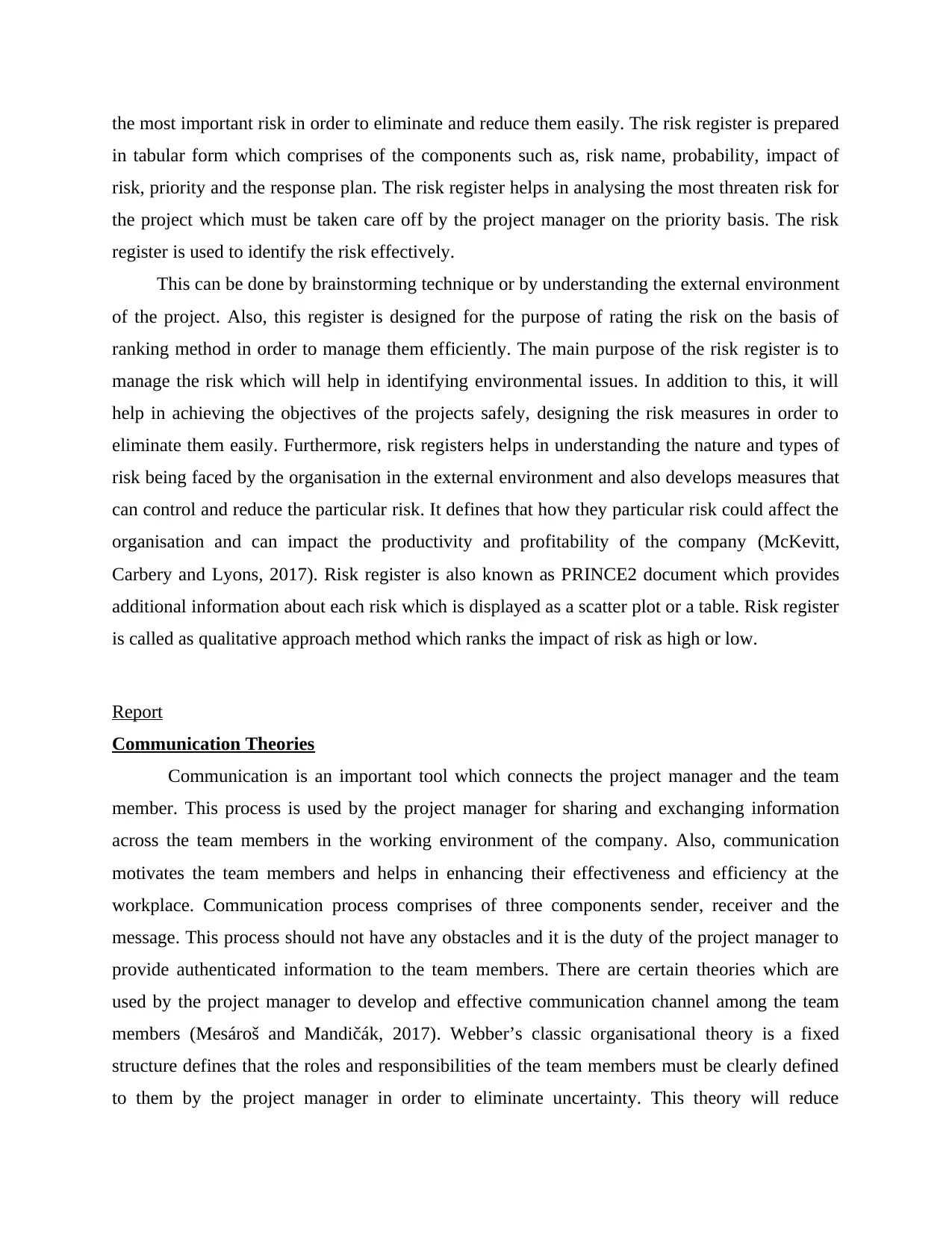
the most important risk in order to eliminate and reduce them easily. The risk register is prepared
in tabular form which comprises of the components such as, risk name, probability, impact of
risk, priority and the response plan. The risk register helps in analysing the most threaten risk for
the project which must be taken care off by the project manager on the priority basis. The risk
register is used to identify the risk effectively.
This can be done by brainstorming technique or by understanding the external environment
of the project. Also, this register is designed for the purpose of rating the risk on the basis of
ranking method in order to manage them efficiently. The main purpose of the risk register is to
manage the risk which will help in identifying environmental issues. In addition to this, it will
help in achieving the objectives of the projects safely, designing the risk measures in order to
eliminate them easily. Furthermore, risk registers helps in understanding the nature and types of
risk being faced by the organisation in the external environment and also develops measures that
can control and reduce the particular risk. It defines that how they particular risk could affect the
organisation and can impact the productivity and profitability of the company (McKevitt,
Carbery and Lyons, 2017). Risk register is also known as PRINCE2 document which provides
additional information about each risk which is displayed as a scatter plot or a table. Risk register
is called as qualitative approach method which ranks the impact of risk as high or low.
Report
Communication Theories
Communication is an important tool which connects the project manager and the team
member. This process is used by the project manager for sharing and exchanging information
across the team members in the working environment of the company. Also, communication
motivates the team members and helps in enhancing their effectiveness and efficiency at the
workplace. Communication process comprises of three components sender, receiver and the
message. This process should not have any obstacles and it is the duty of the project manager to
provide authenticated information to the team members. There are certain theories which are
used by the project manager to develop and effective communication channel among the team
members (Mesároš and Mandičák, 2017). Webber’s classic organisational theory is a fixed
structure defines that the roles and responsibilities of the team members must be clearly defined
to them by the project manager in order to eliminate uncertainty. This theory will reduce
in tabular form which comprises of the components such as, risk name, probability, impact of
risk, priority and the response plan. The risk register helps in analysing the most threaten risk for
the project which must be taken care off by the project manager on the priority basis. The risk
register is used to identify the risk effectively.
This can be done by brainstorming technique or by understanding the external environment
of the project. Also, this register is designed for the purpose of rating the risk on the basis of
ranking method in order to manage them efficiently. The main purpose of the risk register is to
manage the risk which will help in identifying environmental issues. In addition to this, it will
help in achieving the objectives of the projects safely, designing the risk measures in order to
eliminate them easily. Furthermore, risk registers helps in understanding the nature and types of
risk being faced by the organisation in the external environment and also develops measures that
can control and reduce the particular risk. It defines that how they particular risk could affect the
organisation and can impact the productivity and profitability of the company (McKevitt,
Carbery and Lyons, 2017). Risk register is also known as PRINCE2 document which provides
additional information about each risk which is displayed as a scatter plot or a table. Risk register
is called as qualitative approach method which ranks the impact of risk as high or low.
Report
Communication Theories
Communication is an important tool which connects the project manager and the team
member. This process is used by the project manager for sharing and exchanging information
across the team members in the working environment of the company. Also, communication
motivates the team members and helps in enhancing their effectiveness and efficiency at the
workplace. Communication process comprises of three components sender, receiver and the
message. This process should not have any obstacles and it is the duty of the project manager to
provide authenticated information to the team members. There are certain theories which are
used by the project manager to develop and effective communication channel among the team
members (Mesároš and Mandičák, 2017). Webber’s classic organisational theory is a fixed
structure defines that the roles and responsibilities of the team members must be clearly defined
to them by the project manager in order to eliminate uncertainty. This theory will reduce

confusions and conflicts among the working environment which will develop a hierarchical,
clear and structured communication network.
This theory is also known as top down approach as this will fix the responsibilities of the
team members. Another theory is Tompkins and chenny’s organisational control theory which is
an extension of abovementioned theory. The theory considers four kinds of factor namely
simple, technical, conservative and bureaucratic. These factors define that the communication
must have effective networks that will connect the team members with other operational units of
the organisation. Furthermore, they another theory is Deetz’s managerialism theory defines that
the project manager must try to create balance among the organisational interest and the team
members interest (Müller, Packendorff and Sankaran, 2017). This theory defines that an ideal
project manager must be effective in order to control the minds of the team members towards
achieving the project targets timely.
These theory help in establishing an effective channel among the team members and the
project manager. It is necessary for the project manager to select that theory which will suit their
organisational working environment and also helps in attainment of the project goals and
objectives. Another important theory is the cognitive dissonance theory which reduces the
psychological conflict among the project managers and team members. These psychological
conflicts arise due to contradiction and difference in the beliefs and attitudes of the project
members.
Project Methodologies
Agile Methodology
Agile methodology can be defined as a method which can be used by the project manager
to divide the project into several stages which will help in attaining the goals of the project. It
helps in establishment of continuous collaboration among the stakeholders which will guide the
team members for the necessary improvement at every stage. Also, this helps in clarifying the
customer’s expectation to the project team (Pielichaty, Els and Mawer, 2016). After the
beginning of the project cycle the team will go through the process of planning, executing and
evaluating which will help in making an informed decision.
Strengths:
clear and structured communication network.
This theory is also known as top down approach as this will fix the responsibilities of the
team members. Another theory is Tompkins and chenny’s organisational control theory which is
an extension of abovementioned theory. The theory considers four kinds of factor namely
simple, technical, conservative and bureaucratic. These factors define that the communication
must have effective networks that will connect the team members with other operational units of
the organisation. Furthermore, they another theory is Deetz’s managerialism theory defines that
the project manager must try to create balance among the organisational interest and the team
members interest (Müller, Packendorff and Sankaran, 2017). This theory defines that an ideal
project manager must be effective in order to control the minds of the team members towards
achieving the project targets timely.
These theory help in establishing an effective channel among the team members and the
project manager. It is necessary for the project manager to select that theory which will suit their
organisational working environment and also helps in attainment of the project goals and
objectives. Another important theory is the cognitive dissonance theory which reduces the
psychological conflict among the project managers and team members. These psychological
conflicts arise due to contradiction and difference in the beliefs and attitudes of the project
members.
Project Methodologies
Agile Methodology
Agile methodology can be defined as a method which can be used by the project manager
to divide the project into several stages which will help in attaining the goals of the project. It
helps in establishment of continuous collaboration among the stakeholders which will guide the
team members for the necessary improvement at every stage. Also, this helps in clarifying the
customer’s expectation to the project team (Pielichaty, Els and Mawer, 2016). After the
beginning of the project cycle the team will go through the process of planning, executing and
evaluating which will help in making an informed decision.
Strengths:
Secure Best Marks with AI Grader
Need help grading? Try our AI Grader for instant feedback on your assignments.
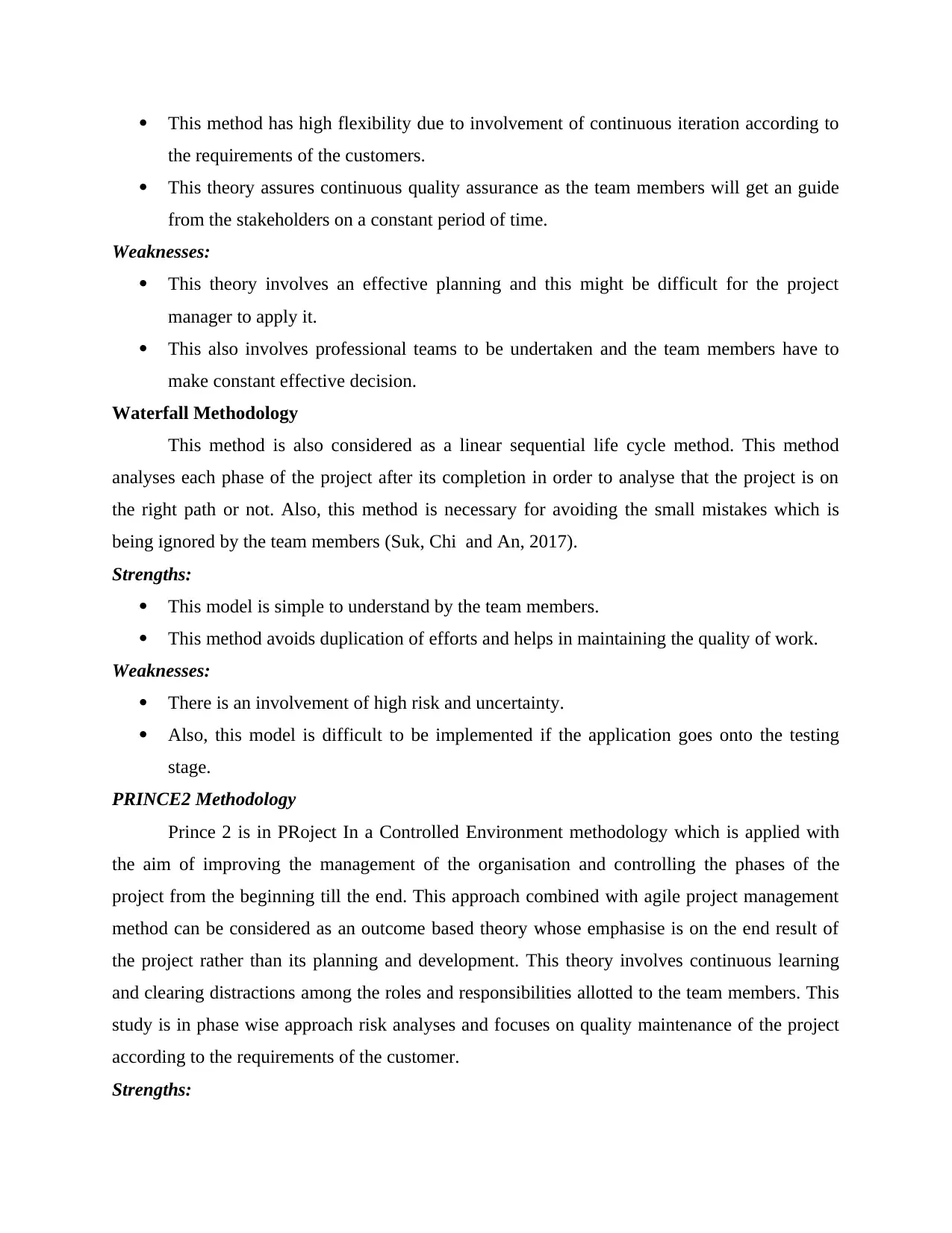
This method has high flexibility due to involvement of continuous iteration according to
the requirements of the customers.
This theory assures continuous quality assurance as the team members will get an guide
from the stakeholders on a constant period of time.
Weaknesses:
This theory involves an effective planning and this might be difficult for the project
manager to apply it.
This also involves professional teams to be undertaken and the team members have to
make constant effective decision.
Waterfall Methodology
This method is also considered as a linear sequential life cycle method. This method
analyses each phase of the project after its completion in order to analyse that the project is on
the right path or not. Also, this method is necessary for avoiding the small mistakes which is
being ignored by the team members (Suk, Chi and An, 2017).
Strengths:
This model is simple to understand by the team members.
This method avoids duplication of efforts and helps in maintaining the quality of work.
Weaknesses:
There is an involvement of high risk and uncertainty.
Also, this model is difficult to be implemented if the application goes onto the testing
stage.
PRINCE2 Methodology
Prince 2 is in PRoject In a Controlled Environment methodology which is applied with
the aim of improving the management of the organisation and controlling the phases of the
project from the beginning till the end. This approach combined with agile project management
method can be considered as an outcome based theory whose emphasise is on the end result of
the project rather than its planning and development. This theory involves continuous learning
and clearing distractions among the roles and responsibilities allotted to the team members. This
study is in phase wise approach risk analyses and focuses on quality maintenance of the project
according to the requirements of the customer.
Strengths:
the requirements of the customers.
This theory assures continuous quality assurance as the team members will get an guide
from the stakeholders on a constant period of time.
Weaknesses:
This theory involves an effective planning and this might be difficult for the project
manager to apply it.
This also involves professional teams to be undertaken and the team members have to
make constant effective decision.
Waterfall Methodology
This method is also considered as a linear sequential life cycle method. This method
analyses each phase of the project after its completion in order to analyse that the project is on
the right path or not. Also, this method is necessary for avoiding the small mistakes which is
being ignored by the team members (Suk, Chi and An, 2017).
Strengths:
This model is simple to understand by the team members.
This method avoids duplication of efforts and helps in maintaining the quality of work.
Weaknesses:
There is an involvement of high risk and uncertainty.
Also, this model is difficult to be implemented if the application goes onto the testing
stage.
PRINCE2 Methodology
Prince 2 is in PRoject In a Controlled Environment methodology which is applied with
the aim of improving the management of the organisation and controlling the phases of the
project from the beginning till the end. This approach combined with agile project management
method can be considered as an outcome based theory whose emphasise is on the end result of
the project rather than its planning and development. This theory involves continuous learning
and clearing distractions among the roles and responsibilities allotted to the team members. This
study is in phase wise approach risk analyses and focuses on quality maintenance of the project
according to the requirements of the customer.
Strengths:
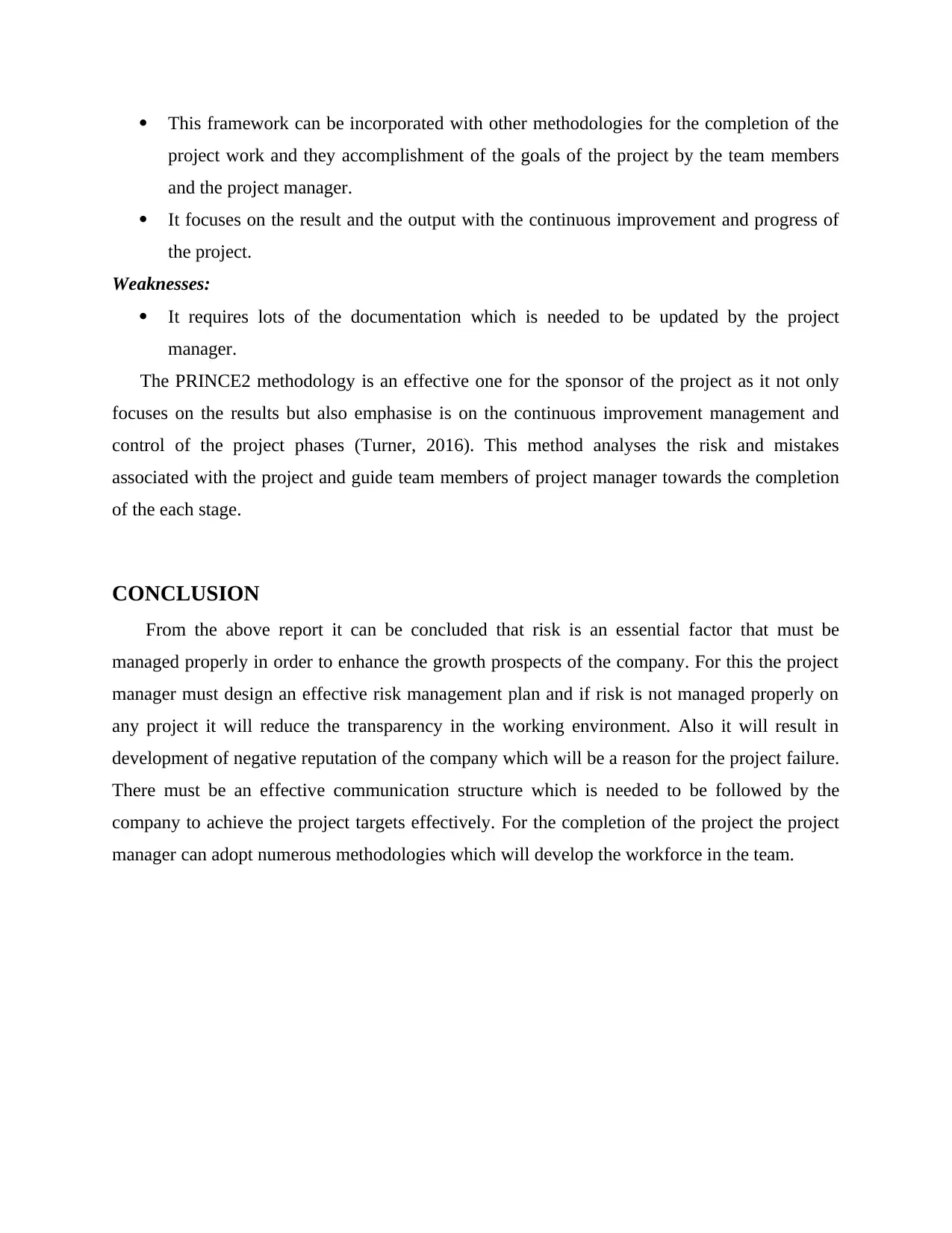
This framework can be incorporated with other methodologies for the completion of the
project work and they accomplishment of the goals of the project by the team members
and the project manager.
It focuses on the result and the output with the continuous improvement and progress of
the project.
Weaknesses:
It requires lots of the documentation which is needed to be updated by the project
manager.
The PRINCE2 methodology is an effective one for the sponsor of the project as it not only
focuses on the results but also emphasise is on the continuous improvement management and
control of the project phases (Turner, 2016). This method analyses the risk and mistakes
associated with the project and guide team members of project manager towards the completion
of the each stage.
CONCLUSION
From the above report it can be concluded that risk is an essential factor that must be
managed properly in order to enhance the growth prospects of the company. For this the project
manager must design an effective risk management plan and if risk is not managed properly on
any project it will reduce the transparency in the working environment. Also it will result in
development of negative reputation of the company which will be a reason for the project failure.
There must be an effective communication structure which is needed to be followed by the
company to achieve the project targets effectively. For the completion of the project the project
manager can adopt numerous methodologies which will develop the workforce in the team.
project work and they accomplishment of the goals of the project by the team members
and the project manager.
It focuses on the result and the output with the continuous improvement and progress of
the project.
Weaknesses:
It requires lots of the documentation which is needed to be updated by the project
manager.
The PRINCE2 methodology is an effective one for the sponsor of the project as it not only
focuses on the results but also emphasise is on the continuous improvement management and
control of the project phases (Turner, 2016). This method analyses the risk and mistakes
associated with the project and guide team members of project manager towards the completion
of the each stage.
CONCLUSION
From the above report it can be concluded that risk is an essential factor that must be
managed properly in order to enhance the growth prospects of the company. For this the project
manager must design an effective risk management plan and if risk is not managed properly on
any project it will reduce the transparency in the working environment. Also it will result in
development of negative reputation of the company which will be a reason for the project failure.
There must be an effective communication structure which is needed to be followed by the
company to achieve the project targets effectively. For the completion of the project the project
manager can adopt numerous methodologies which will develop the workforce in the team.

REFRENCES
Books and Journal
Adeleke, A. Q., Bamgbade, J. A., and Lee, C. K., 2019. Project Management Performance and
Its Influence on Malaysian Building Projects. KnE Social Sciences, pp.313-329.
Bogdanova, M., Parashkevova, E. and Stoyanova, M., 2020. Agile project management in
governmental organizations–methodological issues. International E-Journal of
Advances in Social Sciences, 6(16), pp.262-275.
Kucher, L., Heldak, M. and Orlenko, A., 2018. Project management in organic agricultural
production. Agricultural and Resource Economics: International Scientific E-
Journal, 4(3), pp.104-128.
Kucher, L., Heldak, M. and Orlenko, A., 2018. Project management in organic agricultural
production. Agricultural and Resource Economics: International Scientific E-
Journal, 4(3), pp.104-128.
McKevitt, D., Carbery, R. and Lyons, A., 2017. A profession but not a career? Work identity and
career satisfaction in project management. International Journal of Project
Management, 35(8), pp.1673-1682.
Mesároš, P. and Mandičák, T., 2017, October. Exploitation and benefits of BIM in construction
project management. In IOP Conference Series: Materials Science and
Engineering (Vol. 245, No. 6, p. 062056).
Müller, R., Packendorff, J. and Sankaran, S., 2017. Balanced leadership: A new perspective for
leadership in organizational project management. Cambridge handbook of
organizational project management.
Pielichaty, H., Els, G., and Mawer, V., 2016. Events project management. Taylor & Francis.
Suk, S. J., Chi, S., and An, S. H., 2017. Quantifying combination effects of project management
practices on cost performance. KSCE Journal of Civil Engineering, 21(3), pp.603-615.
Turner, R., 2016. Gower handbook of project management. Routledge.
Books and Journal
Adeleke, A. Q., Bamgbade, J. A., and Lee, C. K., 2019. Project Management Performance and
Its Influence on Malaysian Building Projects. KnE Social Sciences, pp.313-329.
Bogdanova, M., Parashkevova, E. and Stoyanova, M., 2020. Agile project management in
governmental organizations–methodological issues. International E-Journal of
Advances in Social Sciences, 6(16), pp.262-275.
Kucher, L., Heldak, M. and Orlenko, A., 2018. Project management in organic agricultural
production. Agricultural and Resource Economics: International Scientific E-
Journal, 4(3), pp.104-128.
Kucher, L., Heldak, M. and Orlenko, A., 2018. Project management in organic agricultural
production. Agricultural and Resource Economics: International Scientific E-
Journal, 4(3), pp.104-128.
McKevitt, D., Carbery, R. and Lyons, A., 2017. A profession but not a career? Work identity and
career satisfaction in project management. International Journal of Project
Management, 35(8), pp.1673-1682.
Mesároš, P. and Mandičák, T., 2017, October. Exploitation and benefits of BIM in construction
project management. In IOP Conference Series: Materials Science and
Engineering (Vol. 245, No. 6, p. 062056).
Müller, R., Packendorff, J. and Sankaran, S., 2017. Balanced leadership: A new perspective for
leadership in organizational project management. Cambridge handbook of
organizational project management.
Pielichaty, H., Els, G., and Mawer, V., 2016. Events project management. Taylor & Francis.
Suk, S. J., Chi, S., and An, S. H., 2017. Quantifying combination effects of project management
practices on cost performance. KSCE Journal of Civil Engineering, 21(3), pp.603-615.
Turner, R., 2016. Gower handbook of project management. Routledge.
1 out of 10
Related Documents
Your All-in-One AI-Powered Toolkit for Academic Success.
+13062052269
info@desklib.com
Available 24*7 on WhatsApp / Email
![[object Object]](/_next/static/media/star-bottom.7253800d.svg)
Unlock your academic potential
© 2024 | Zucol Services PVT LTD | All rights reserved.





